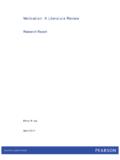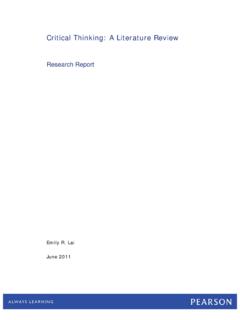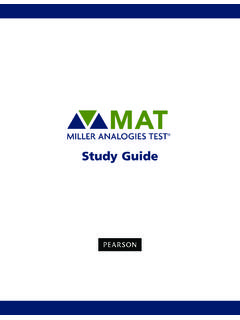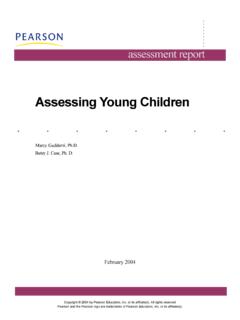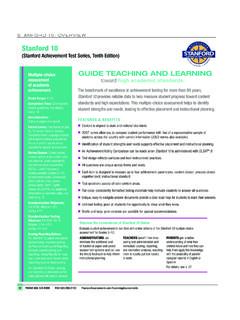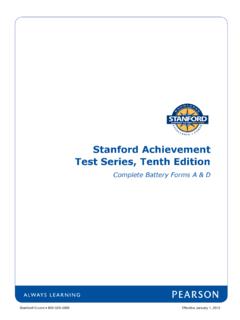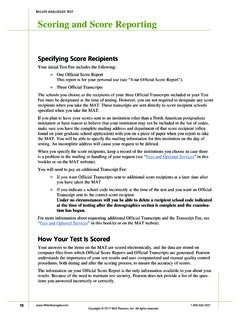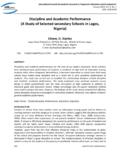Transcription of Collaboration: A literature review - Assessment & …
1 collaboration : a literature review Research Report Emily R. Lai June 2011 collaboration 1 About Pearson Pearson, the global leader in education and education technology, provides innovative print and digital education materials for preK through college, student information systems, and learning management systems, teacher licensure testing, teacher professional development, career certification programs, and testing and Assessment products that set the standard for the industry. Pearson s other primary businesses include the Financial Times Group and the Penguin Group. For more information about the Assessment & Information group of Pearson, visit About Pearson s Research Reports Pearson s research report series provides preliminary dissemination of reports and articles prepared by TMRS staff, usually prior to formal publication.
2 Pearson s publications in .pdf format may be obtained at: collaboration 2 Abstract collaboration is the mutual engagement of participants in a coordinated effort to solve a problem together. Collaborative interactions are characterized by shared goals, symmetry of structure, and a high degree of negotiation, interactivity, and interdependence. Interactions producing elaborated explanations are particularly valuable for improving student learning. Nonresponsive feedback, on the other hand, can be detrimental to student learning in collaborative situations. collaboration can have powerful effects on student learning, particularly for low-achieving students. However, a number of factors may moderate the impact of collaboration on student learning, including student characteristics, group composition, and task characteristics.
3 Although historical frameworks offer some guidance as to when and how children acquire and develop collaboration skills, there is scant empirical evidence to support such predictions. However, because many researchers appear to believe children can be taught to collaborate, they urge educators to provide explicit instruction that encourages development of skills such as coordination, communication, conflict resolution, decision-making, problem-solving, and negotiation. Such training should also emphasize desirable qualities of interaction, such as providing elaborated explanations, asking direct and specific questions, and responding appropriately to the requests of others. Teachers should structure tasks in ways that will support the goals of collaboration , specify ground rules for interaction, and regulate such interactions.
4 There are a number of challenges in using group-based tasks to assess collaboration . Several suggestions for assessing collaboration skills are made. Keywords: collaboration , collaborative learning, cooperation, group Assessment collaboration 3 Acknowledgements The author thanks Janet Fowler for assistance in conducting literature searches and the following reviewers for their helpful comments and suggestions on an earlier draft of this paper: Ha Phan, Jolana Rivas, Tian Song, and Changjiang Wang. collaboration 4 collaboration : a literature review Educators in a variety of educational settings from K12 to the university classroom have long used collaborative approaches to teaching and assessing students. More recently, educators and policy makers have identified the ability to collaborate as an important outcome in its own right rather than merely a means to an end.
5 For example, the Partnership for 21st Century Skills has identified collaboration as one of several learning and innovation skills necessary for post-secondary education and workforce success. In addition, the newly-created Common Core State Standards reflect collaboration as a communication skill vital for college and employment. The purposes of this literature review are to (a) explore how researchers have defined collaboration ; (b) investigate how collaboration skills develop; (c) learn how teachers can encourage development of collaboration skills in their students; and (d) review best practices in assessing collaboration skills. Definition of collaboration Theoretical Perspectives Collaborative learning is broadly defined as a situation in which two or more people learn or attempt to learn something together, and more specifically as joint problem solving (Dillenbourg, 1999, p.)
6 1). Roschelle and Teasley define collaboration more specifically as mutual engagement of participants in a coordinated effort to solve a problem together, (as cited in Dillenbourg et al., 1996, p. 2). Dillenbourg notes the difficulty of agreeing on a definition of collaborative learning, even among experts. Ambiguity in the meaning of collaborative learning stems from several sources. First, the scale of such interactions may range from two people to thousands, with different theoretical tools needed to analyze interactions occurring at different collaboration 5levels. Second, the question of what constitutes learning is a source of uncertainty. As Dillenbourg (1999) explains, researchers use learning to refer to several different types of activities: students studying course materials together for a test; joint problem solving in which learning is assumed to occur as a by-product of interactions; learning as a biological and/or cultural process that takes place over several years (p.
7 4); and learning from collaborative work, which refers to the lifelong acquisition of expertise within a professional community (p. 4). Dillenbourg notes that nothing is inherently instructive about working with more than one person on a task; rather, interaction triggers learning processes. Collaborative learning situations require instructions, a physical setting, and other kinds of performance constraints. These elements do not guarantee collaboration ; they only make it more likely. Roschelle (1992) frames collaboration as an exercise in convergence or construction of shared meanings and notes that research on conversational analysis has identified features of interactions that enable participants to reach convergence through the construction, monitoring, and repairing of shared knowledge.
8 Convergence occurs gradually, but tends to include four elements: a) construction of an abstract understanding of the problem s deep structure; b) the interplay of metaphors; c) an iterative cycle of displaying, confirming, and repairing conceptions; and d) application of progressively higher standards of evidence for convergence. Similarly, Roschelle and Teasley (1995) define collaboration as coordinated, synchronous activity that is the result of a continued attempt to construct and maintain a shared conception of a problem collaboration 6(p. 70). They define the joint problem space as the shared knowledge structure that supports problem-solving by integrating goals, descriptions of the current problem state, and awareness of potential strategies, as well as the links between these things.
9 According to Roschelle and Teasley, collaboration takes place within this joint problem space, which provides the structure needed to allow meaningful conversations about the problem. To construct a joint problem space, partners must have ways to introduce and accept knowledge, monitor exchanges for evidence of divergent meanings, and repair any divergences identified. As Van Boxtel, et al. (2000) explain, collaborative learning activities allow students to provide explanations of their understanding, which can help students elaborate and reorganize their knowledge. Social interaction stimulates elaboration of conceptual knowledge as group mates attempt to make themselves understood, and research demonstrates that providing elaborated explanations improves student comprehension of concepts.
10 Once conceptual understandings are made visible through verbal exchange, students can negotiate meaning to arrive at convergence, or shared understanding. Qualities of Collaborative Learning collaboration is sometimes distinguished from cooperative learning in that cooperation is typically accomplished through the division of labor, with each person responsible for some portion of the problem solving. collaboration , on the other hand, involves participants working together on the same task, rather than in parallel on separate portions of the task. However, Dillenbourg et al. (1996) note that some spontaneous division of labor may occur during collaboration . Thus, the distinction between the two is not necessarily clear-cut. According to Dillenbourg et al. (1996), in cooperation, the task is split hierarchically into independent sub- collaboration 7tasks and coordination is only required for assembling partial results.
